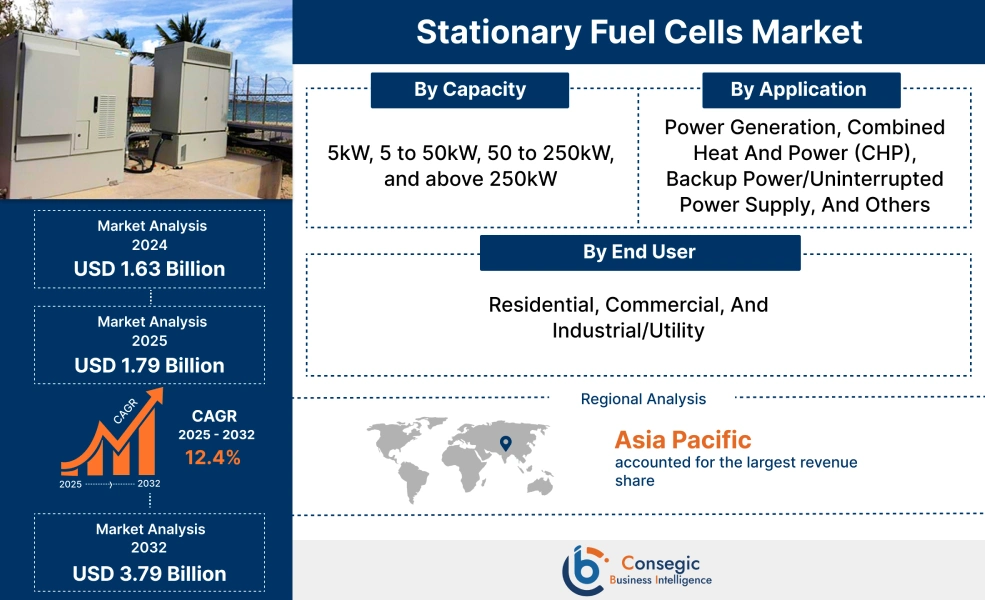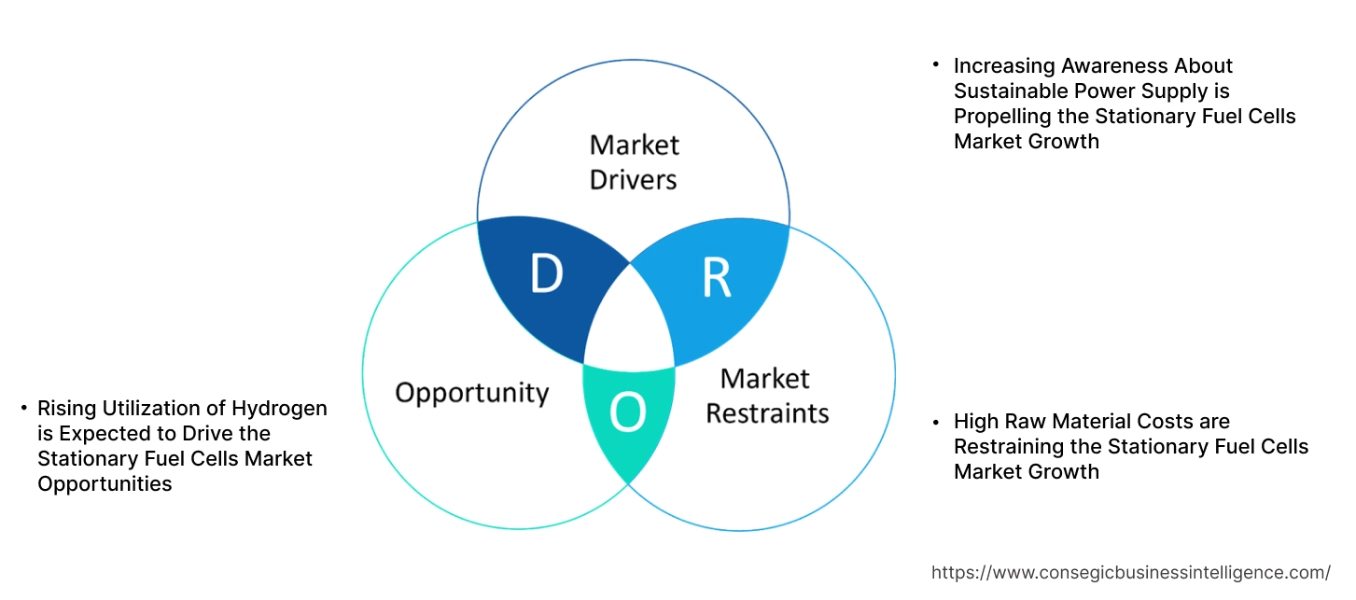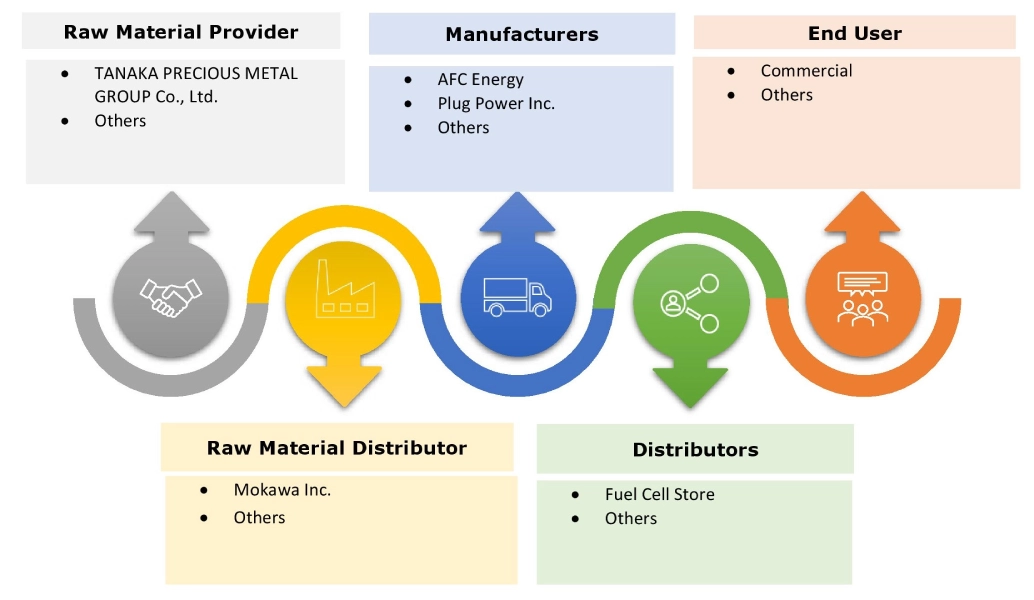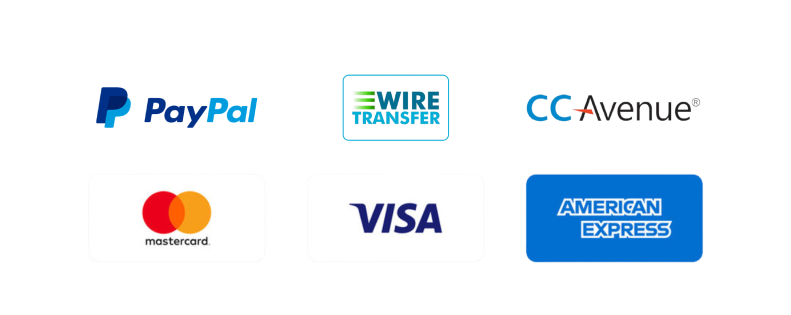Stationary Fuel Cells Market Size:
Stationary Fuel Cells Market size is estimated to reach over USD 3.79 Billion by 2032 from a value of USD 1.63 Billion in 2024 and is projected to grow by USD 1.79 Billion in 2025, growing at a CAGR of 12.4% from 2025 to 2032.
Stationary Fuel Cells Market Scope & Overview:
Stationary fuel cells refer to power generation systems that produce electricity without any combustion. The fuel cells can provide clean and reliable power for backup. Further, the fuel cells can provide stable and long-duration power for equipment used in data centers and micro grids. Moreover, the rising adoption of stationary fuel cells to improve air quality by reducing emissions from fuel-based energy systems is driving the market. Additionally, fuel cells have experienced increasing utilization due to quiet operation, reduced maintenance, and fuel flexibility.
How is AI Transforming the Stationary Fuel Cells Market?
AI is increasingly being used in the stationary fuel cells market, particularly for facilitating faster and more optimized design through generative design tools, enhancing predictive maintenance and performance optimization for increased efficiency and longevity, and improving energy management through real-time data analysis for improved grid integration. Moreover, AI integration also aids in safety by monitoring for leaks and managing power distribution, while facilitating quicker market intelligence for faster decision-making and increased adoption of fuel cell technology. Further, AI-powered systems are used in fuel cell manufacturing for accelerated design and optimization, enhanced manufacturing processes, real-time monitoring and fault diagnosis, among others. Therefore, the aforementioned factors are expected to positively impact the market growth in upcoming years.
Key Drivers:
Increasing Awareness About Sustainable Power Supply is Propelling the Stationary Fuel Cells Market Growth
Fuel cells generate electricity through an electrochemical reaction instead of combustion which results in a clean supply of energy. Moreover, rising regulatory requirements to reduce emissions and promote clean energy are driving the market. Additionally, the rising commercialization of fuel cells for industrial and commercial use due to high efficiency and low transmission loss compared to conventional power generation systems is driving the overall market.
- For instance, in March 2023, Honda announced that the company began operation of stationary fuel power stations on its corporate premises in California. The fuel cell power station supplies clean backup power to the data center present in the premises.
Hence, the increasing awareness about sustainable power supply to reduced emissions is driving the stationary fuel cells market size.
Key Restraints:
High Raw Material Costs are Restraining the Stationary Fuel Cells Market Growth
Fuel cells typically utilize precious metals namely platinum and iridium to act as catalysts. The cost of iridium is increased due to concentrated supply of the metal which can result in shortage. Moreover, rising utilization of platinum in different industries including automotive, jewelry, and electronics has resulted in the price increase of the metal, in turn, acting as a restraint to the market growth.
Thus, high raw material costs due to limited supply of iridium and demand for platinum from other industries act as a restraint to the stationary fuel cells market expansion.
Future Opportunities :
Rising Utilization of Hydrogen is Expected to Drive the Stationary Fuel Cells Market Opportunities
Hydrogen fuel cells convert the chemical energy of hydrogen into electrical energy. Additionally, the fuel cells combine hydrogen and oxygen to generate electricity which results in minimal pollution. Moreover, hydrogen fuel cells provide a clean source of energy, as the byproducts during operation are only heat and water which is driving the market.
- For instance, in February 2022, Bosch installed two stationary fuel-cell systems at a Deutsche Telekom site in Berlin that utilize natural gas with an admixture of hydrogen. The company intends to switch to green hydrogen in the long term to make the project completely carbon free.
Thus, the rising utilization of hydrogen due to minimal pollution and less byproducts during operation is projected to drive the stationary fuel cells market opportunities during the forecast period.
Stationary Fuel Cells Market Segmental Analysis :
By Capacity:
Based on the capacity, the market is segmented into up to 5kW, 5 to 50kW, 50 to 250kW, and above 250kW.
Trends in the capacity:
- Increasing adoption of 5 to 50kW with rugged enclosure design for outdoor uses is driving the stationary fuel cells market share.
- Rising utilization of 50 to 250kW that features fewer parasitic loads and smaller dimensions is driving the stationary fuel cells market trends.
5 to 50kW accounted for the largest revenue share in the year 2024
- 5 to 50kW fuel cell generators have experienced a rising adoption in demonstration events and construction sites, which has resulted in the stationary fuel cells market expansion.
- Additionally, there has been a rising adoption of output adjustment function to adjust the power output in small increments which is driving the global stationary fuel cells market.
- Moreover, the increasing number of 5 to 50kW fuel cell generator offerings that are powered by hydrogen is driving the market.
- For instance, AFC Energy offers L Series fuel cell generators that feature up to 40kW power and are powered by hydrogen.
- According to the market analysis, the rising advancements related to continuous dryers due effective drying of high-viscosity liquids is driving the stationary fuel cells market trends.
50 to 250kW is anticipated to register the fastest CAGR during the forecast period.
- There has been a rising adoption of 50 to 250kW with an operating temperature range of 50-80°C which is driving the market.
- Moreover, the rising number of 50 to 250kW fuel cell systems offered by manufacturers that are designed to work with battery energy storage systems is boosting the market.
- For instance, EH Group offers EH-81/84 fuel cell stacks for mobile and stationary applications. The fuel stacks can be customized for client applications namely heavy duty mobility and back-up power.
- Thus, the increasing utilization of 50 to 250kW due to integration with battery energy storage systems is driving the overall market.
By Application:
Based on the application, the market is segmented into power generation, combined heat and power (CHP), backup power/uninterrupted power supply, and others.
Trends in the application:
- Increasing adoption of fuel cells for power generation due to low maintenance is driving the market trends.
- There has been a rising utilization of fuel cells for backup power due to need for uninterrupted power supply during grid outages, driving the stationary fuel cells market demand.
Power generation accounted for the largest revenue share in the year 2024.
- Fuel cells have experienced a rising adoption in remote locations that are not connected to the grid.
- Further, the rising utilization of fuel cells due to compatibility with conventional and renewable primary power sources is driving the stationary fuel cells market demand.
- Moreover, manufacturers have started fuel cell systems that are cost-effective and reliable for providing power during events which is driving the market.
- For instance, INOCEL offers hydrogen fuel cells for off-grid power generation without needing to be connected to the electrical grid.
- Thus, as per the analysis, the rising adoption of fuel cell for power generation due to use in remote locations and compatibility with conventional power sources is driving the market.
Backup power/uninterrupted power supply is anticipated to register the fastest CAGR during the forecast period.
- Fuel cell systems have experienced a rising utilization in industries such as telecommunication where an outage in electricity grid can have serious consequences.
- Moreover, manufacturers have started offering fuel cell systems that provide continuous electricity to the electrical system in the event of a blackout.
- For instance, Plug Power offers GenSure fuel cells that are able to provide robust and reliable backup power for hundreds of hours, making them the ideal backup power source compared to traditional sources.
- Therefore, the rising utilization of fuel cells for backup power/uninterrupted power supply due to continuous supply of electricity in the event of a blackout is driving the market.
By End User:
Based on the end user, the market is segmented into residential, commercial, and industrial/utility.
Trends in the end user:
- Increasing adoption of fuel cells in industrial/utility due to fuel flexibility is driving the market trends.
- Rising adoption of stationary fuel cells in commercial applications due to quiet operation is driving the market growth.
Industrial/utility accounted for the largest revenue share of 45.14% in the year 2024.
- Fuel cells have experienced a rising adoption in industrial/utility sector due to their ability to perform in extreme conditions which has driven the global stationary fuel cells market.
- Further, rising utilization of fuel cells to strengthen grid reliability by acting as a complementary source of energy is driving the market demand.
- Moreover, the increasing utilization of fuel cells to balance supply during peak usage of electricity by temporality switching of energy to certain areas is driving the market.
- Therefore, the increasing demand for fuel cells in industrial/utility due to strengthening of the grid and ability to perform in harsh conditions is driving the stationary fuel cells market size.
Commercial is anticipated to register the fastest CAGR during the forecast period.
- Fuel cells have experienced a rising adoption in commercial spaces namely hospitals and buildings due to reduced carbon emissions.
- Moreover, the rise in the adoption of fuel cells in data centres to handle low and high power demands is driving the growth of the market.
- For instance, FuelCell Energy offers fuel cells solutions in data centers for various applications including electricity generation and data center cooling.
- According to the stationary fuel cells market analysis, the rising trend in the adoption of fuel cells in residential due to reduced energy costs and increasing number of government incentives is propelling the stationary fuel cells industry during the forecast period.
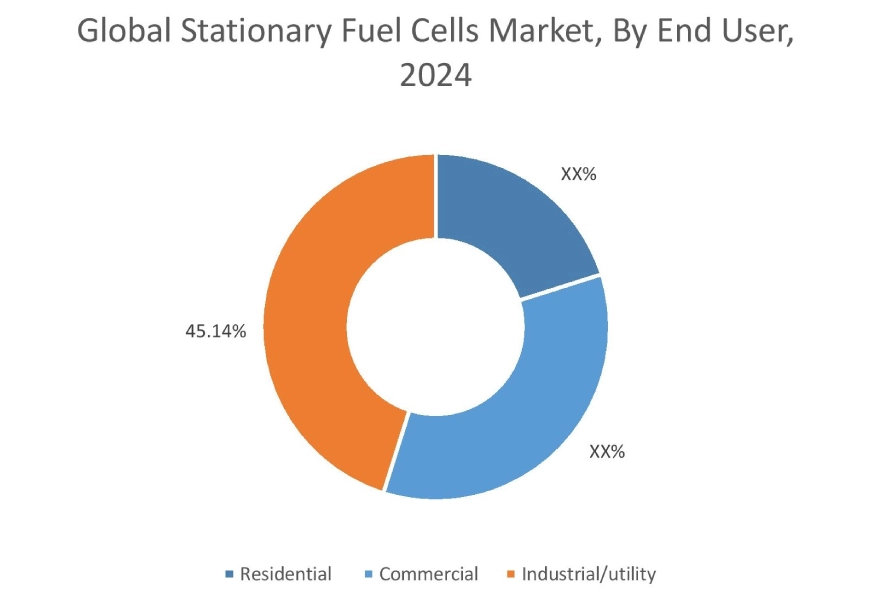
Regional Analysis:
The regions covered are North America, Europe, Asia Pacific, the Middle East and Africa, and Latin America.
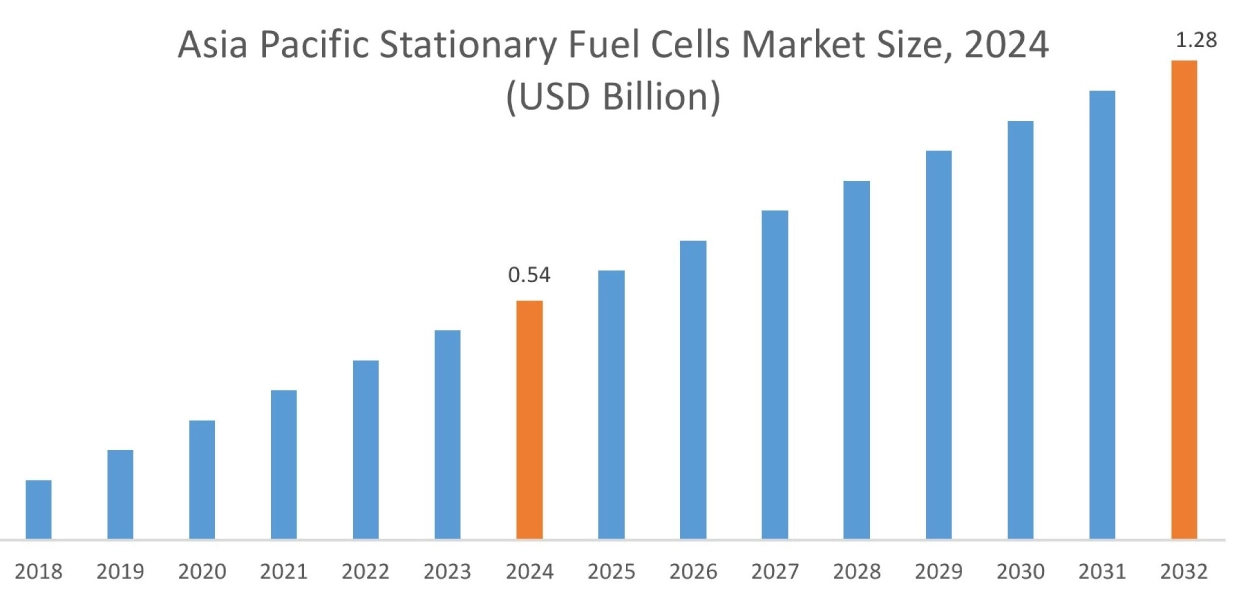
Asia Pacific region was valued at 0.54 Billion in 2024. Moreover, it is projected to grow by 0.59 Billion in 2025 and reach over 1.28 Billion by 2032. Out of this, China accounted for the maximum revenue share of 33.79%. As per the stationary fuel cells market analysis, the growth in the Asia-Pacific region is primarily driven by the increasing investments in the production of green hydrogen.
- For instance, the Ministry of New and Renewable Energy plans to set up at least two green hydrogen hubs for large scale production of hydrogen by providing an outlay of approximately USD 47 million up to 2025-26. The rise in investments for green hydrogen production is expected to boost the market as hydrogen has experienced a rising adoption for powering fuel cells.
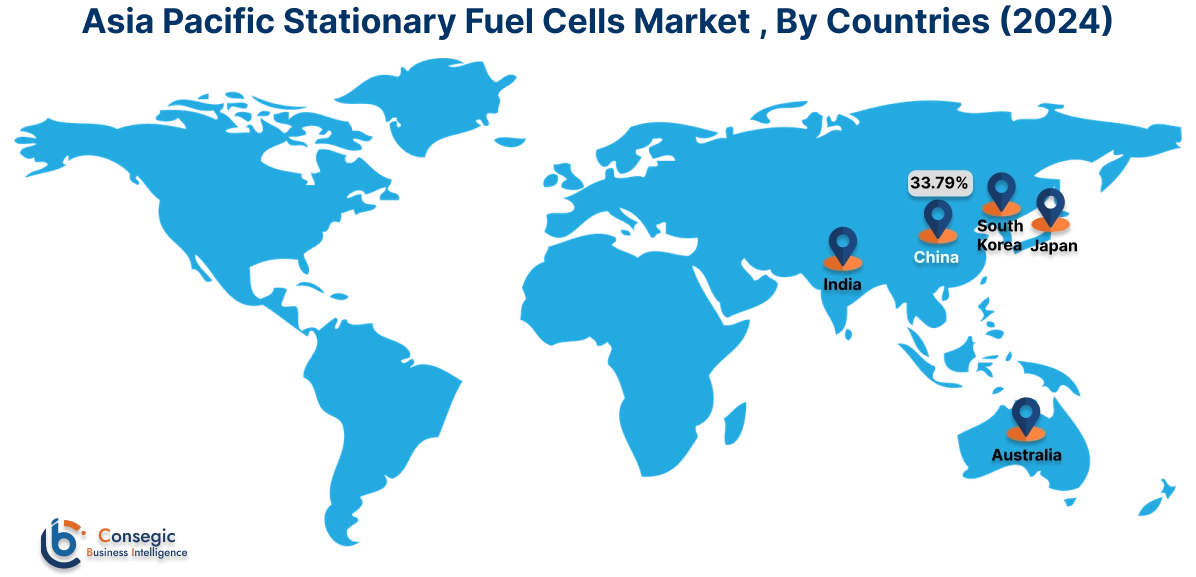
North America is estimated to reach over USD 1.09 Billion by 2032 from a value of USD 0.47 Billion in 2024 and is projected to grow by USD 0.51 Billion in 2025. In North America, the growth of stationary fuel cells industry is driven by the increasing adoption of fuel cells for combined heat and power. Moreover, the increasing utilization of fuel cells in residential areas has resulted in the rise of stationary fuel cells market share.
- For instance, the U.S. government offers tax credits of up to USD 500 per half kW of power capacity for fuel cells. The rise in government incentives is expected to boost the market as fuel cells become a lucrative power source among consumers due to the incentives.
Additionally, the regional analysis depicts stringent environmental regulations and the rising utilization of fuel cell systems in residential areas is driving the market demand in Europe. Furthermore, as per the market analysis, the market demand in Latin America is expected to grow at a considerable rate due to rising awareness about clean energy. Middle East and African regions are expected to grow at a considerable rate due to factors such as rapid urbanization and rising investments by data centers.
Top Key Players and Market Share Insights:
The global stationary fuel cells market is highly competitive with major players providing solutions to the national and international markets. Key players are adopting several strategies in research and development (R&D), product innovation, and end-user launches to hold a strong position in the stationary fuel cells market. Key players in the stationary fuel cells industry include-
- AFC Energy (U.K.)
- Fuji Electric Co., Ltd. (Japan)
- AISIN CORPORATION (Japan)
- FuelCell Energy, Inc. (U.S.)
- Toshiba Energy Systems & Solutions Corporation (Japan)
- Bosch GmbH (Germany)
- Plug Power Inc. (U.S.)
- Cummins Inc. (U.S.)
- INOCEL (France)
- Denso Corporation (Japan)
Recent Industry Developments :
Product Launches:
- In February 2025, Honda unveiled the specs for its next generation fuel cell module and fuel cell power generator at H2 and FC EXPO. The mass production of the fuel cell module is expected to begin in 2027 while the mass production of the fuel cell power generator is expected to begin in 2026.
- In April 2024, Panasonic announced that its Electric Works Company is set to unveil a new hydrogen fuel cell generator in October 2024. The fuel cell generator features maximum power output of 10kW and continuous power generation of about 168 hours.
Stationary Fuel Cells Market Report Insights :
| Report Attributes | Report Details |
| Study Timeline | 2019-2032 |
| Market Size in 2032 | USD 3.79 Billion |
| CAGR (2025-2032) | 12.4% |
| By Capacity |
|
| By Application |
|
| By End User |
|
| By Region |
|
| Key Players |
|
| North America | U.S. Canada Mexico |
| Europe | U.K. Germany France Spain Italy Russia Benelux Rest of Europe |
| APAC | China South Korea Japan India Australia ASEAN Rest of Asia-Pacific |
| Middle East and Africa | GCC Turkey South Africa Rest of MEA |
| LATAM | Brazil Argentina Chile Rest of LATAM |
| Report Coverage |
|
Key Questions Answered in the Report
How big is the stationary fuel cells market? +
The stationary fuel cells market was valued at USD 1.63 Billion in 2024 and is projected to grow to USD 3.79 Billion by 2032.
Which is the fastest-growing region in the stationary fuel cells market? +
Asia-Pacific region is experiencing the most rapid growth in the stationary fuel cells market.
What specific segmentation details are covered in the stationary fuel cells market report? +
The stationary fuel cells market report includes capacity, application, end user and region.
Who are the major players in the stationary fuel cells market? +
The key participants in the stationary fuel cells market are AFC Energy (U.K.), Bosch GmbH (Germany), Plug Power Inc. (U.S.), Cummins Inc. (U.S.), INOCEL (France), Denso Corporation (Japan), Fuji Electric Co., Ltd. (Japan), AISIN CORPORATION (Japan), FuelCell Energy, Inc. (U.S.), Toshiba Energy Systems & Solutions Corporation (Japan), and Others.
